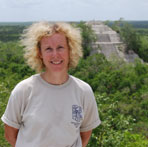

 |
Sheryl Luzzadder-Beach | Department of Earth Systems and GeoInformation Sciences, GMU We use geological and archaeological evidence to understand the formation of patterned ground in perennial and seasonal wetlands in the karst depressions of Belize. Some scholars have argued that these features are the remnants of ancient Maya wetland fields, or chinampas, on which intensive cultivation produced food that could begin to nourish the extremely high population of the Late Classic (A.D. 550-850). Others have argued that these were natural features, or that they represent landscape manipulation for rising sea level in the Preclassic (1000 B.C. –A.D. 250). We present the evidence for ancient intensive agriculture and natural landscape formation with multiple proxies: excavated field and canal features, artifacts, pollen, radiocarbon dating, soil stratigraphy, and water chemistry. Evidence thus far suggests that many regional depressions have Preclassic (1200 BC to AD 200) or earlier paleosols, buried from 1-2 m by eroded soils induced by Maya land use practices, largely in the upland zones. These paleosols were buried by eroded sediments from uplands and by precipitation of gypsum in the lowlands from rising, saturated groundwater. The sedimentation occurred largely between the Preclassic and Late Classic, when ancient Maya farmers built canals to reclaim these wetlands. Further dating and field evidence shows a period of canal building and use of wetlands in the late Classic Maya Period. Thus, stable natural processes, environmental change, and human manipulation have acted together to form patterned wetland ground over the later Holocene. |